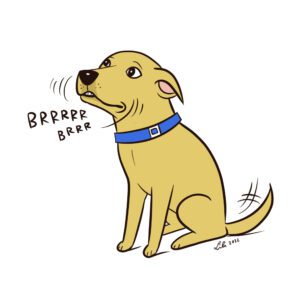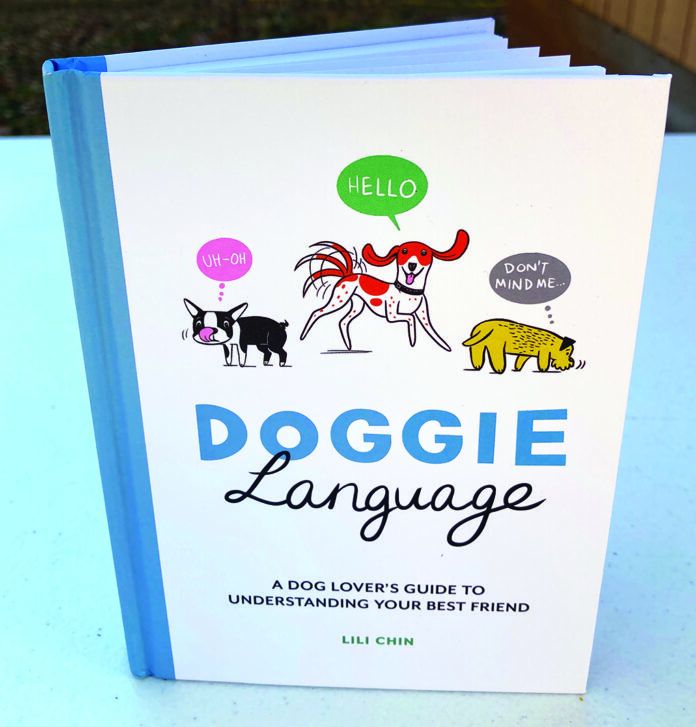I recently asked one of our regular contributors to write an article explaining why dogs might display a teeth-chattering behavior. The article came back, and then it was my turn to look for a photograph of a dog with chattering teeth to accompany the article.
I spent HOURS looking through stock photos of dogs online, and as well as through the thousands of my own stock photos of dogs, which I’ve been taking for the more than 25 years that I’ve been editing WDJ. I have spent many hours taking photos of dogs in dog parks, and I thought the chances were good that I would find a frame of a dog with chattering teeth in those photos; I know I have observed the behavior at dog parks before. But – no luck. I couldn’t find a single frame of a dog whose mouth even slightly resembled the posture of teeth-chattering.
Then I remembered a very valuable resource about dog body language: Doggie Language: A Dog Lover’s Guide to Understanding Your Best Friend, by Lili Chin, dog illustrator extraordinaire. I just knew the behavior would be in the book, which I promoted in our 2021 “Gear of the Year” feature.



It turned out, that while Chin has captured and succinctly explained most of the critically important canine postures that all dog owners should know, from friendly nose touches to stiff, narrowly wagging tails, “chattering teeth” was not illustrated! But I’m aware that Chin has collaborated with and drawn educational dog-behavior illustrations for many professional force-free dog trainers, and offers these in poster form on her website, doggiedrawings.net. I looked through these for a while; there are some great infographics there! But nothing on teeth-chattering.
I was despondent, for a minute. But then I thought: “I’ll write to Lili! I’ll ask her if she has ever illustrated this anywhere ever before, and if I can use that illustration!”
And I did.
And she hadn’t.
But then, 15 minutes later, she sent me a note that said, “How is my five-minute effort?” with this:

It’s perfect! It captures a dog’s anxious expression, with softly flattened ears, a tentative posture, barely wagging tail, and a slightly puckered mouth – just how dogs often look when they chatter their teeth, whether that’s due to anxiety, or because they just smelled something interesting (like another dog’s urine), or because they are genuinely cold!
Doggie Language Is a Terrific Resource
Chin’s talent for capturing complex canine behavior in a simple illustration inspired me to recommend her book again now, at the perfect gift-giving time of year: it’s not expensive and it is easily procured (available anywhere books are sold, and if you want a signed copy, available from doggielanguagebook.com). It’s a great gift for anyone who loves dogs or has a new dog. It’s also available in 16 languages!
Ignore the fact that Doggie Language doesn’t cover “teeth chattering” – it’s a pretty subtle and not-very-common behavior. What the book does depict, with clear and simple illustrations and very brief explanations, are the most important words and phrases that dogs are telling us with their body language. Any trainer can tell you that few owners perceive the many signs of stress in their dogs – early warnings that they need space (and might bite to get it). How does a dog look when they are truly interested in exchanging affection with a person? How can you tell which dog is excited and friendly dog and which one is frantic and frustrated? Even a young child can recognize the differences using Chin’s illustrations and descriptions.
And, before I forget, if your dog sometimes chatters his teeth, and you want to learn more about that behavior, read “Chatter of Fact” here.







My dog has always done this when I spray him or brush his teeth.
I love to get authors and illustrators autographs on books.
The only time I have observed one of my dogs chattering their teeth is while they were asleep. I assumed it was a dream. As a puppy, she used to suckle in her sleep. Yes, I spend a lot of my time watching my dogs sleep.